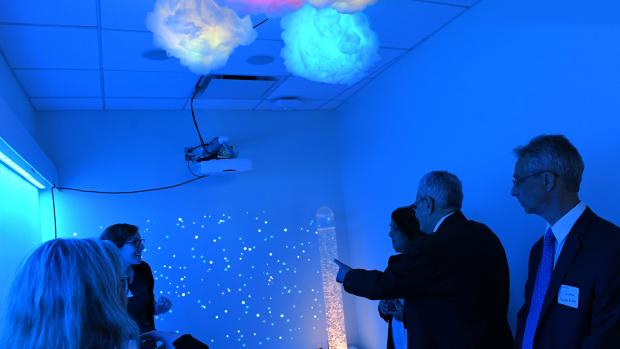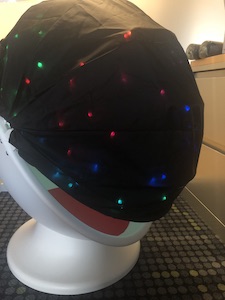Patients at NYU’s new Oral Health Center for People with Disabilities stay comfortable and calm thanks to Tandon IDM students

Color-changing “cloud” light fixtures and a projection wall on display at NYU's new Oral Health Center for People with Disabilities.
There are an estimated 950,000 people in New York City with some form of disability, and an enormous number of them face steep barriers to getting adequate dental care: many doctors’ offices lack access for patients in wheelchairs, for example, and those with autism spectrum disorders or sensory issues can find the harsh lighting and cacophony of sounds in a conventional office disturbing.
The recently opened Oral Health Center for People with Disabilities (OHCPD), which occupies a floor at the NYU College of Dentistry’s Weissman Building, was designed to provide state-of-the-art dental services with dignity, respect, and patient comfort foremost in mind. The facility boasts one of only two-dozen special wheelchair recliners in the entire U.S., allowing patients to avoid making a laborious (and in some cases actually impossible) transfer to a dental chair — and thanks to Tandon’s Integrated Digital Media (IDM) students, it also features an innovative waiting room, designed specifically to calm anxious patients, especially those on the autism spectrum.

“The students took part under the auspices of the multidisciplinary NYU Ability Project, which aims to foster collaboration between those with disabilities and engineers, designers, occupational and physical therapists, and others,” Lexie Rosenberg, the occupational therapist supervising the students, explained. “Working on the sensory waiting room turned out to be a gratifying and learning-filled experience for everyone involved.”
Luna Wang, who worked on a vibrating wall designed to soothe and relax patients who touch it, concurred. “We went through several iterations of our prototype, making it more stable and adding a colorful cover,” she said. “It was a great exercise in human-centered design that works on a practical level to solve problems for real people, and it’s wonderful to know it’s now benefitting patients.”
 In addition to the wall, IDM students designed:
In addition to the wall, IDM students designed:
-
An enclosed “egg” chair, which cocoons nervous patients and bathes them in lights that gently change color
-
Color-changing “cloud” light fixtures
-
A projection wall that provides visual stimulus
Liz Betts, who worked on the egg chair prototype, found herself greatly impressed with the OHCPD, which is headed by pediatric dentist Ronald Kosinski. “It’s filling such an important niche, and I feel very proud to have played some small part in its design,” she said.




